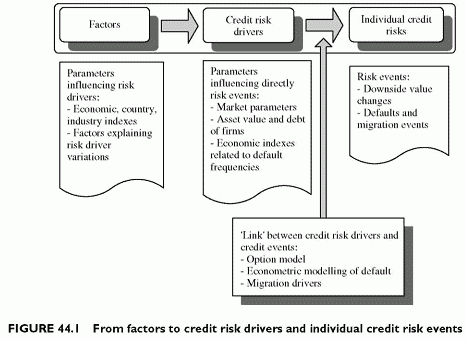FACTOR MODELS AND CREDIT RISK CORRELATIONS
Category: Risk Management in Banking
Correlating credit risk events, defaults or migrations, necessitates correlating their risk drivers. Unlike market risk drivers, credit risk drivers are unobservable. They are asset values of firms or economic indexes related to country-industry factors (CPV). In addition, the link between credit risk drivers and credit events is not as simple as the variation of value of market instruments sensitive to market parameters. Hence credit risk models face a double difficulty when addressing correlations between credit events: linking risk drivers to credit events; finding correlations between unobservable credit risk drivers.
To address the first difficulty, they use an intermediate modelling block linking the credit risk drivers to credit events. In the option framework, the link with the firms asset value is the option model of default. In the econometric modelling of CPV, the logit function relates directly an economic index modelled as a function of several economic factors to the default rate of portfolio segments. To address the second difficulty, they model risk drivers as a function of factors which, unlike risk drivers, are observable or derived from observable variables. The intuition is that common factors influence the credit standing of obligors. In some cases, the factors influencing this risk are observable. They are the country or industry indexes that influence the default probability through a logit function. In other cases, factors are derived from observed variables, but are not observable. For instance, KMV Portfolio Manager models asset values as a function of orthogonal factors, composites of observable variables.
The entire process comprises different stages. Credit risk events derive from risk drivers, such as asset values or economic indexes. Correlations between credit events result from correlations between these risk drivers. Correlations between unobservable credit risk drivers result from factor models. For this reason, we refer to risk drivers as variables influencing directly credit risk events, and to the parameters influencing risk drivers as risk factors (Figure 44.1).
The next sections discuss the module linking credit events to credit risk drivers before moving on to factor models.

